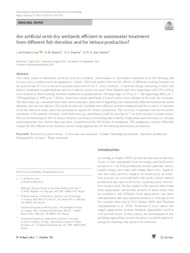Are artificial semi-dry wetlands efficient in wastewater treatment from different fish densities and for lettuce production?
Are artificial semi-dry wetlands efficient in wastewater treatment from different fish densities and for lettuce production?
Resumo: This study aimed to determine artifcial semi-dry wetlands' performance to wastewater treatment from fish farming and Lactuca sativa production in an aquaponics system. This trial model observed the effects of different stocking biomass on the growth rate of Colossoma macropomum and yield of two L. sativa varieties. A factorial design consisting of three fish density treatments in quadruplicate and two Lettuces variety was used. Nine hundred and sixty fingerlings with 8.35±0.91 g were stocked at three stocking biomass treatments in quadruplicate: 40 fingerlings or 334 g m-3; 80 fingerlings 668 g m-3; 120 fingerlings or 1002 g m-3. Delice American Lettuce and Purple Crested Lettuce were cultured in the semi-dry wetlands. The fnal mass (g), consumed food, feed conversion ratio, and yield of fngerling were statistically diferent between the tested densities, but survival did not. The artificial semi-dry wetlands were efcient on water treatment and the recovery of nutrients in all fsh densities trials, and it has potential as support for lettuce production. The recovery of nutrients was shown on the increment of the number of leaves, total fresh mass (g), and lettuces yield by area (kg m-2) in both varieties of plants tested. Precocious fowering in 30% of lettuce varieties, incidence of mealybug and whitefly, temperature and defciency of calcium and magnesium were factors that may have compromised the full lettuce development. The aquaponics system eficiently treated the fsh efuent at the densities tested, being appropriate for fish farming and lettuces production.
Ano de publicação: 2021
Tipo de publicação: Artigo de periódico
Unidade: Embrapa Amapa
Observações
1 - Por padrão são exibidas publicações dos últimos 20 anos. Para encontrar publicações mais antigas, configure o filtro ano de publicação, colocando o ano a partir do qual você deseja encontrar publicações. O filtro está na coluna da esquerda na busca acima.
2 - Para ler algumas publicações da Embrapa (apenas as que estão em formato ePub), é necessário ter, no celular ou computador, um desses softwares gratuitos. Sistemas Android: Google Play Livros; IOS: iBooks; Windows e Linux: software Calibre.
Acesse outras publicações
Acesse a Base de Dados da Pesquisa Agropecuária (BDPA) para consultar o acervo completo das bibliotecas da Embrapa.

